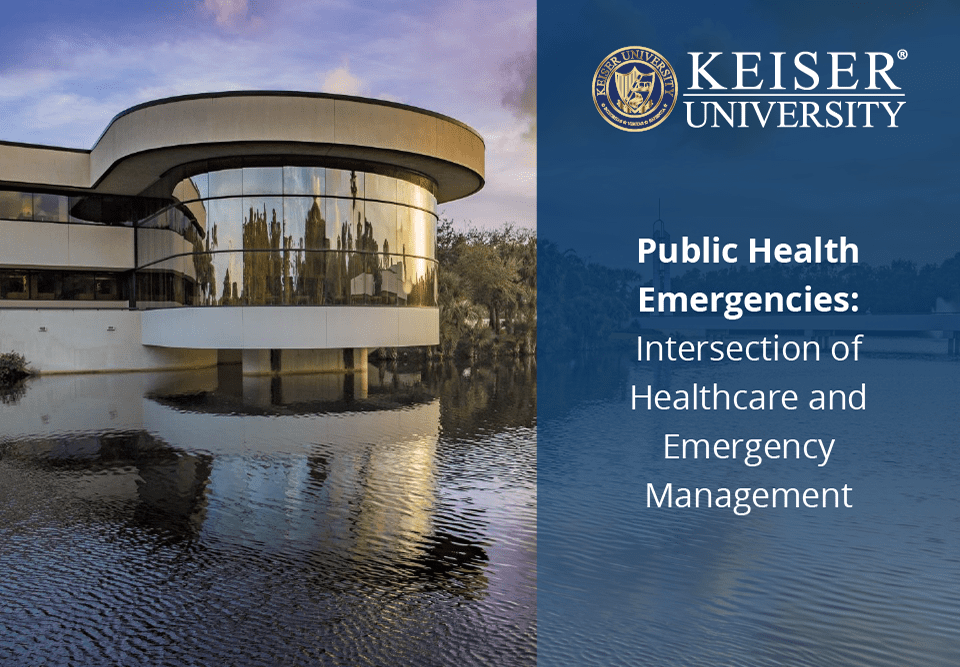Unlike single, isolated tragedies, public health emergencies are widespread events that affect multiple people simultaneously. Some take shape over time, while others occur suddenly. Regardless of how they develop, it’s important to have a public health emergency management plan.
What Are Public Health Emergencies?
So, what is a public health emergency? Put simply, they are events — whether natural or man-made — that threaten a population’s health and well-being. According to the National Governors Association, they vary in scope and require the help of public health experts and government organizations. Examples of public health emergencies include natural disasters, industrial accidents, epidemics and human-caused disasters.
Public Health Emergency Preparedness (PHEP)
Public health emergency preparedness, or PHEP, plays a pivotal role in disaster management. According to the Centers for Disease Control, the PHEP cooperative agreement provides funding for state, local and territorial departments to create public health emergency management plans and agencies.
One of the most well-known agencies is the Federal Emergency Management Agency (FEMA). In addition to crafting preparedness plans, FEMA offers disaster assistance, puts together relief packages and reduces the impact of future emergencies.
The Role of Emergency Management
Effective emergency management requires a proactive, collaborative approach. According to the Occupational Safety and Health Administration, it involves:
Planning and Preparedness
Although public health emergencies can be difficult to predict, advanced preparation is still helpful. A strong public health emergency management plan should account for:
- Critical incident response
- Legal readiness
- Funding
- Healthcare and emergency management workforce efforts
- Infrastructure
- Communication plans
Coordination and Communication
Effective communication and cohesive coordination are at the core of any emergency management strategy. In the event of a public health emergency, government leaders, public health experts, healthcare professionals, first responders and emergency management experts will need to work together to implement the response plan and inform the public.
Resource Allocation
During public health emergencies, critical care resources are scarce. Emergency management professionals work closely with public health experts and government leaders to maximize resource allocation, helping ensure that those who need resources the most receive them as quickly as possible.
Mitigation and Recovery
Public health emergencies have both short-term and long-term impacts. For example, a natural disaster or epidemic could lead to an immediate influx of critical care patients as well as mental health challenges down the line.
The Role of Healthcare
The best emergency response plans blend emergency management with healthcare, helping meet both the immediate and long-term needs of affected populations. Data from the World Health Organization shows that hospital systems play a crucial role in emergency response and management, with administrators and healthcare professionals working to maximize aid and minimize response times.
During a public health crisis, hospitals and healthcare professionals may provide:
Frontline Response
Whether a community is reeling from a mass casualty event, a global health crisis or an epidemic, hospitals need to have adequate staffing and resources available to quickly support patients. As a result, healthcare leaders should work in advance to create efficient frontline response plans. By prioritizing staffing levels and resource allocation, these plans can help ensure that patients are triaged effectively.
Surveillance and Reporting
Data collection efforts by healthcare professionals allow public health and emergency management experts to continue monitoring the impact of large-scale health issues. Surveillance and reporting are particularly important during global health crises and disease outbreaks, as data can be used to monitor the spread of disease and provide the public with reliable, accurate information.
Capacity Building
Capacity building is a coordinated effort that involves evaluating existing capacity, then developing a strategic plan for increasing capacity in case of emergencies. Advanced, proactive capacity building can improve outcomes during a public health crisis and ensure that everyone affected receives prompt and attentive care.
Continuity of Care
There’s no doubt that public health emergencies can significantly disrupt daily life. However, it’s important that these unexpected situations don’t disrupt operations at healthcare facilities. Proactive capacity building — such as increasing staff, supplies and bed availability — can improve public health preparedness, including disaster and recovery efforts and response times.
How Healthcare and Emergency Management Work Together
Healthcare professionals and emergency management experts create dynamic, strategic public health emergency management plans, often working together through:
Healthcare Coalitions
According to the Department of Health and Human Services, healthcare coalitions are groups of healthcare and response organizations that work to build emergency response plans. Often created based on geographic proximity, they may include hospital administrators, emergency management experts, emergency medical services providers and public health agencies.
Healthcare Emergency Management Programs
Healthcare emergency management programs are training programs that help develop the skills needed to create and implement public health preparedness plans. During training, healthcare professionals learn about everything from improving disaster assistance to minimizing financial losses.
Emergency Operations Plans
In the event of a public health emergency, healthcare providers and emergency management professionals need to know who is responsible for individual tasks. Emergency operations plans define roles, responsibilities and resources for every stage of a disaster, ensuring that everyone knows what they’re supposed to do.
Joint Training Exercises
Joint training exercises allow healthcare providers, emergency responders and emergency management professionals to engage in simulated experiences that mimic real-life public health emergencies. Not only does this help build experience with disaster assistance, but it also allows professionals to identify areas that need improvement.
Building Community Resilience
In addition to collaborating with one another, healthcare organizations and emergency management agencies need to engage the local community to raise awareness and increase public health preparedness.
Engaging Communities
Emergency response planning is an ongoing initiative, and success depends heavily on community engagement. According to the Rural Health Information Hub, healthcare professionals and emergency management experts can support communities by offering training exercises and encouraging individuals to create their own preparedness plans.
Addressing Social Vulnerabilities
A social vulnerability index helps identify individuals who may face greater risks during a public health emergency and are more likely to need support and relief packages. Common risk factors include socioeconomic status, limited English proficiency and a lack of access to healthcare.
Strengthening Social Infrastructure
Prior to a public health emergency, healthcare coalitions and government leaders should collaborate to strengthen social infrastructure. For example, improving access to transportation and technology can assist with future disaster and recovery efforts.
Similarities Between Healthcare and Emergency Management
Public health emergency response planning and strategic emergency management share common goals and strategies, such as:
Recovery and Continuity of Operations
Both sectors prioritize maintaining essential services during a crisis. Continuity plans help minimize disruptions and preserve critical operations throughout an emergency.
Resource Management
Resource allocation and management is also a crucial element of any emergency response plan. By allocating resources accordingly, experts can make sure that the most dire needs are addressed first.
Preparedness and Response Coordination
Healthcare and emergency management experts work together to ensure that any emergency response plan is well coordinated and that everyone understands their personal responsibilities.
Explore the Leading Public Health Emergency Management Strategies at Keiser University Graduate School
The scope and severity of public health emergencies can vary greatly, which means emergency management professionals need to be prepared. The Master of Arts in Homeland Security and Emergency Management at Keiser University Graduate offers the expertise and credentials required to navigate both internal and external public health threats. As an educational partner of the Department of Homeland Security, we give current and aspiring professionals an opportunity to earn a skills-based, industry-focused graduate degree that helps make a difference during times of crisis.
Contact a graduate admissions counselor today to learn more about our graduate degree programs.






 The instructors at Keiser University impacted my life. They believed in my ability to become a great graphic designer, regardless of how I felt about my skills. KU helped to prepare me for the real world and got me to where I am today.
The instructors at Keiser University impacted my life. They believed in my ability to become a great graphic designer, regardless of how I felt about my skills. KU helped to prepare me for the real world and got me to where I am today.
